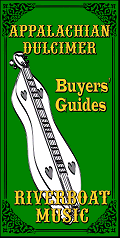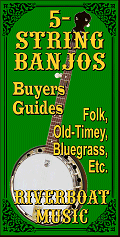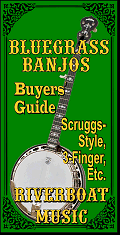Acoustic Instrument
Primers
What Kind of Guitar
Should I Start On?
What Kind of Banjo
Do I Want?
Evaluating and
Buying Used
Guitars
Setting Up
Fretted Instruments Whatever Happened
to the Banjo?
Beginning Five-
String Banjo
6-String Banjos
Banjo Pickups
Axes in my Life
What is a
Bluegrass Banjo?
Dean "Backwoods
Six" Shootout
Music Theory
Primers
Introduction
to Scales
Introduction
to Chords
Circle of Fifths
Other Articles
About Music
How to Give
Guitar Lessons
Musician or
Wannabe? Did God Really
Give Rock &
Roll to You?
Are You a
"Brand Bigot"?
Who Owns Folk Songs?
Historical Links
About the
National Road
The Story Behind
the Story - Real
People, Places,
and Events
About the Play
Play Home
What's New
Overview
About the
Music
About the
History
About the
Logistics
About the
Cast
Synopsis
About the
Set
About the
Author
Contact Us
Home




|

|



Beginning Five-String Folk Banjo - Part 12 - Minor Keys
| Written by Paul Race for Creek Don't RiseTM and School Of The RockTM |
This is a follow-up to our articles on playing in various keys and tunings, including Standard ("C") Tuning, Raised Fifth (DBGDa) banjo tuning and Other Keys and Tunings
So far we have explored only major keys. Now it's time to turn to the "dark side," with minor keys.
Hopefully you recall what we said about "relative minor" keys back in Lesson 6. Every major chord has a minor chord that is related to it, three half-steps down. For example, the relative minor of C is Am and the relative minor of G is Em.
To get a better idea of how these relationships work, with your banjo in G tuning, play the following chords. Note: The little "8" under the treble clef on the first two examples means that the notes you are playing are actually an octave down from the notes shown on the staff.
Go back and forth a few times, and you'll get a "feel" for this chord relationship.
You'll also notice, especially if you look at the little piano notes, that the outside two notes of every chord are the same distance apart - 7 half-steps. It's the middle note that changes.
On the G and C chord, the middle note is a "major third." This means that;
On the Em and Am chord, the middle note is a "minor third." This means that;
Some minor-key songs behave as if they are actually in their relative major until they hit the last chord, with all of the other chords being chords that belong to the relative major key. For example, a song in A minor may use C, F, G, Dm, and Em, all of which belong to the "key of C."
Other minor-key songs behave as if they are firmly grounded in the key of the tonic, and the only reason they're minor-key songs is that the tonic is minor. So an A minor song may use D and E or E7 exactly the same way that a song in A Major would - instead of Dm and Em, the "correct" .
The next bit is just to demonstrate the difference between A Major and A minor.
What Does It Mean for a Song to be in a Minor Key? - When someone says a song is in a minor key, that usually means that the Tonic (First, I) chord of the song is in a minor key. In the two song examples we use in this lesson, the tonic chords are A minor and D minor respectively. So we say that the songs are in A minor and D minor. It is possible, as you'll see later, for other chords in the song to be entirely unexpected, and even for the song to end on a chord besides the Tonic (John Jacob Niles' "I Wonder as I Wander" seems to end on the subdominant). But if the "heart of the song" seems to be a minor chord, most people will consider the song to be in a minor key.
Do You Need to Retune to Play Songs in Minor Keys? - Not necessarily. Many traditional banjo players do retune their banjos to play certain songs in minor keys. For example, some songs are traditionally played in "G minor" tuning. For that, you drop the second string a half-step from B to Bb (DBbGDg). Such retunings vary from song to song and from player to player, so we're just giving you a heads' up for now.
We're going to start out with two minor keys you can play in Raised Fifth tuning (DBGDa) - Am and Dm.
Accompaniment - The important part of this exercise is to get used to alternating between fretting the 3rd and 4th strings at the second fret for the alternating bass of the Am chord. If this seems tough to you, remember that Bluegrass guitar players do this all the time on the C chord, and they're not any smarter than you, are they?
To hear an mp3 of this arrangement click this icon: A Minor
So far we've been playing A minor as shown in the first chord chart to the right, which leaves the fourth string unplayed. When you're playing in the key of Am, however, it's helpful to be able to use the fourth string as well. You do that by fretting the third and fourth string alternatively, going back and forth between the two chords shown at the right. 

In the example to the right you use this technique to provide an "alternating bass" part on the Am chord. 

To add some more color and "bite" to this part, try "hammering on" on both the 3rd and 4th strings. 

Example 1: "Drill, Ye Tarriers, Drill"
We'll start with a simple accompaniment to an old work song about the Irish workers who pounded holes into rock where the railroad needed to blast tunnels.  In this arrangement, we're only going to use two chords, Am and a version of E that has no third at all, so you can't tell whether it is major or minor. The basic chord (Esus4) is shown at the right. That said, you never actually hit the third string in the arrangement below.
In this arrangement, we're only going to use two chords, Am and a version of E that has no third at all, so you can't tell whether it is major or minor. The basic chord (Esus4) is shown at the right. That said, you never actually hit the third string in the arrangement below.
 To print a pdf file of this arrangement, click on the score below.
To print a pdf file of this arrangement, click on the score below.

Solo Version - As is our wont, we are also including a solo version of this song. One feature of this exercise is that it exposes you to one way of playing solos "up the neck" a little, so you should practice it a little if you can. Sooner or later, if you get any good, someone's going to ask you to take a solo on a song that has an insane range, and you'll be better off if you have some idea of how to do it. That said, I don't know anybody besides myself who plays a 5-string banjo solo on this particular song, so if you get the "general principles" of the thing and never really learn it well enough to play for anyone else, don't beat yourself up about it.
To hear an mp3 of this arrangement click this icon:  To print a pdf file of this arrangement, click on the score below.
To print a pdf file of this arrangement, click on the score below.

Example 2: "What Do You do With a Drunken Sailor?"
Our second example is in the key of D minor. This key gives you the option of playing either an outright minor chord, or playing a "no third" chord that makes it sound more "old-timey" or "mountainy," like an Appalachian dulcimer. The second is easier, but some folks prefer the sound of the full minor chord.| The basic Dm chord in Raised Fifth (DBGDa) tuning includes an F note on the first string. The "no 3rd" version of this chord leaves the first string open, which gives you a D note, the same note the second string is playing. Which is better? It depends on the song and your tastes. The first sounds fuller; the second is easier to play.
On some Dm songs, I go back and forth. For example, I might play the Dno3rd version on the verse, but go to the Dm version when I want a fuller sound in the chorus. |

|  |
in Raised Fifth (DBGDa) tuning |
in Raised Fifth (DBGDa) tuning |
In the arrangement below, the tabulature actually uses Dno3rd where the chord says Dm. Try the pattern with both versions of the chord to see which you like.
To hear an mp3 of this arrangement click this icon:  To print a pdf file of this arrangement, click on the score below.
To print a pdf file of this arrangement, click on the score below.

Solo Version - This solo is a little easier than the one above. You'll notice that on measure 4, when we should go down to a low C we don't. Because in this tuning you can't go down to a low C. Nobody will notice, I promise - they'll just assume that the low C got buried with the other notes that happen on that beat.
If your life depends on hearing that low C, you could put your banjo into DBGCa tuning and ajust all of the other parts you're playing accordingly, but to me life's too short.
To hear an mp3 of this arrangement click this icon:  To print a pdf file of this arrangement, click on the score below.
To print a pdf file of this arrangement, click on the score below.

The Trouble With Minor Songs
You thought I was going to say they're sad. The truth is, in many cultures, including modern Jewish cultures, many happy songs are put into minor keys.The real problem is that much of what we have said about related chords up to now seems to go out the window. There are many reasons for this, including:
- Many minor tunes are carry-overs from eras before modern tonalities were established.
- Many minor songs draw both from their own key (say, Am or Dm) and from their relative major key (say C or F).
- Some minor songs go back and forth between the minor and their relative major ("Greensleeves"/"What Child is This" being the classic example).
- Many minor tunes are harmonized with major versions of their Dominant (Fifth) chord. For example, the Dominant of A minor is technically E minor. But in some A minor songs, E or E7 is substituted for E minor to give it a G# "leading tone," emphasizing the E chord's "Dominant" function.
That's why we "hedged our bets" on our arrangements of "Drill Ye Tarriers, Drill," by using an Esus4 chord - some older arrangements use Em for the dominant, but most modern arrangements would use an E or E7. So our arrangement will work with either version.
Some folks would say that, when it comes the "rules of harmony" for minor key songs, "all bets are off." That's not strictly true - there still rules that are generally followed, but the ways they are applied vary among cultures, periods, and genres.
If you stick with banjo and play in a wide range of circumstances, you'll eventually catch on and be able to predict most of the chord changes of most minor key songs just like you can, hopefully, do for most major key songs by now. But for now the best thing to do for now is to find a chord chart or lead sheet (with chords) for any minor key songs you want to learn in the meantime.
Conclusion
This lesson was simply to expose you to playing in minor keys, not to make you crazy by showing you all of the possible variations.Until you're a lot farther along than you are now, take each new minor key song you learn as it comes. Eventually, if you stick with banjo, you'll figure out the typical patterns, although there will always be a few that you need to learn by rote.
In the meantime please contact us if you have any questions or hit any brick walls.
All material, illustrations, and content of this web site is copyrighted © 2001, 2002, 2003, 2004, 2005, 2006,
2007, 2008, 2009, 2010, 2011, 2012, 2013, 2014, 2015 by Paul D. Race. All rights reserved.
Creek Dont' Rise(tm) is a participant in the Amazon Services LLC Associates Program, an affiliate advertising
program designed to provide a means for sites to earn advertising fees by advertising and linking to Amazon.com.
For questions, comments, suggestions, trouble reports, etc. about this play or about this web page, please contact us.
| Visit related pages and affiliated sites: | ||||||
| - Music - | ||||||

|
 |
 |

|

|

|
|

|

|

|

|

|

|
|
| - Trains and Hobbies - | ||||||
 |

|

|  |
 |

|
|
| - Christmas Memories and Collectibles - | ||||||
 |

|
 |

|
 |

|
|
| - Family Activities and Crafts - | ||||||
 |

|

|

|

|

|
|










